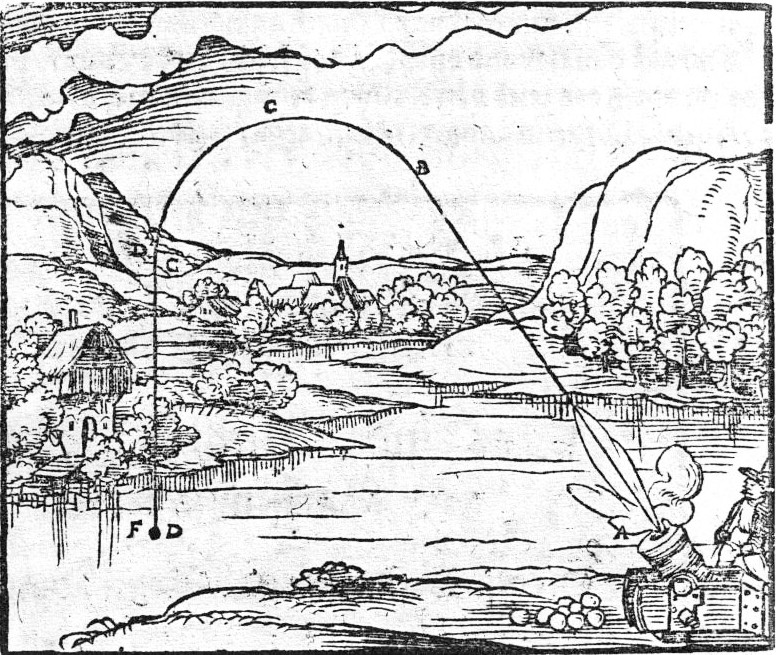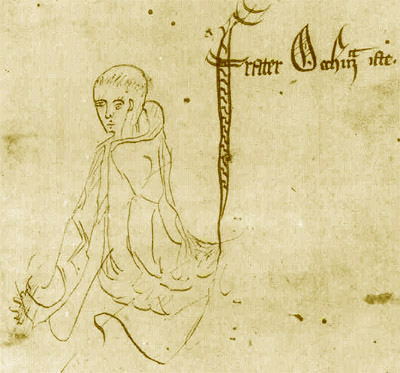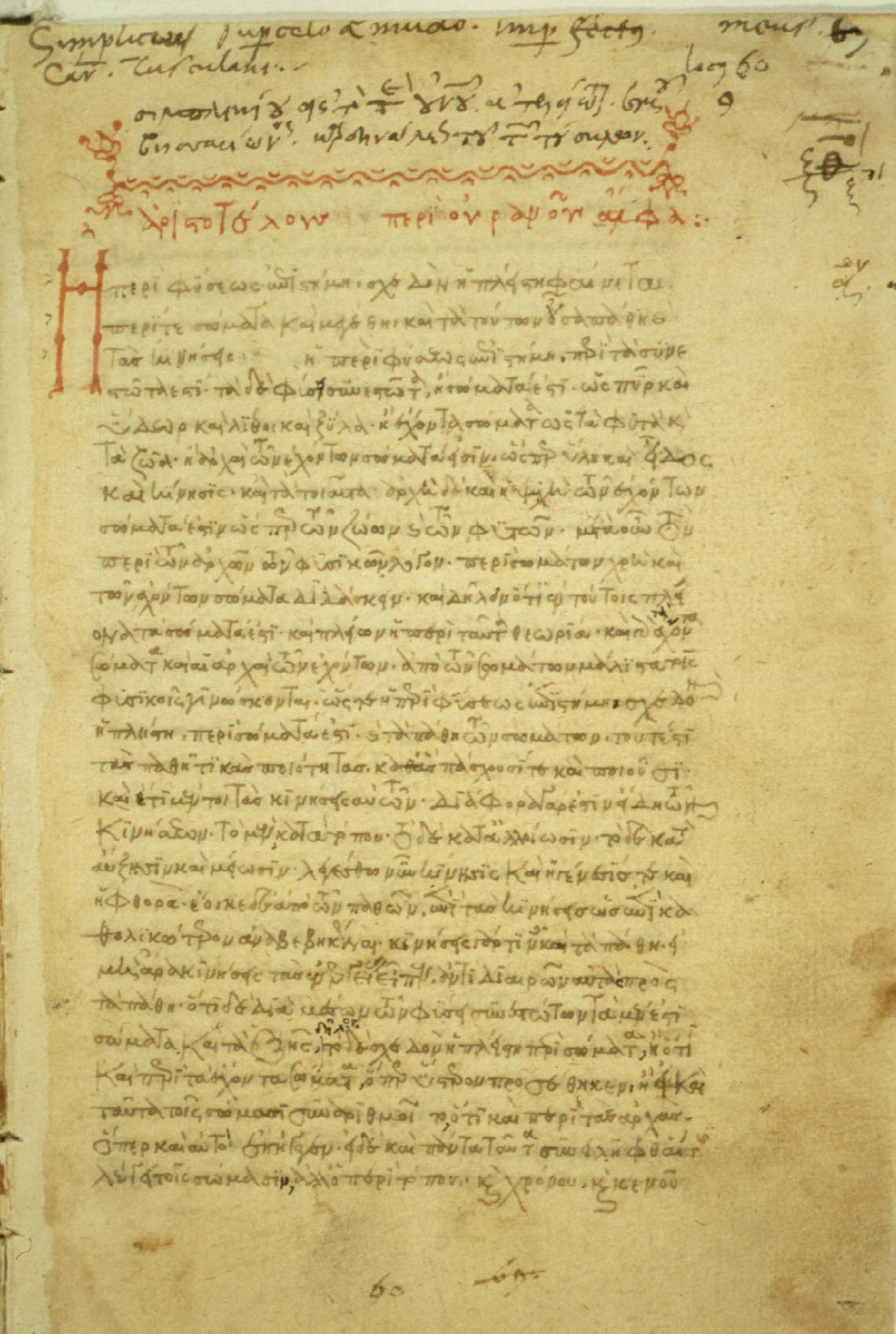|
Theory Of Impetus
The theory of impetus, developed in the Middle Ages, attempts to explain the forced motion of a body, what it is, and how it comes about or ceases. It is important to note that in ancient and medieval times, motion was always considered absolute, relative to the Earth as the center of the universe. The theory of impetus is an auxiliary or secondary theory of Aristotelian dynamics, put forth initially to explain projectile motion against gravity. Aristotelian dynamics of forced (in antiquity called “unnatural”) motion states that a body (without a moving soul) only moves when an external force is constantly driving it. The greater the force acting, the proportionally greater the speed of the body. If the force stops acting, the body immediately returns to the natural state of rest. As we know today, this idea is wrong. It also states—as clearly formulated by John of Jadun in his work ''Quaestiones super 8 libros Physicorum Aristotelis'' from 1586—that not only motion bu ... [...More Info...] [...Related Items...] OR: [Wikipedia] [Google] [Baidu] |
Natural Philosophy
Natural philosophy or philosophy of nature (from Latin ''philosophia naturalis'') is the philosophical study of physics, that is, nature and the physical universe, while ignoring any supernatural influence. It was dominant before the development of modern science. From the ancient world (at least since Aristotle) until the 19th century, ''natural philosophy'' was the common term for the study of physics (nature), a broad term that included botany, zoology, anthropology, and chemistry as well as what is now called physics. It was in the 19th century that the concept of science received its modern shape, with different subjects within science emerging, such as astronomy, biology, and physics. Institutions and communities devoted to science were founded. Isaac Newton's book '' Philosophiæ Naturalis Principia Mathematica'' (1687) (English: ''Mathematical Principles of Natural Philosophy'') reflects the use of the term ''natural philosophy'' in the 17th century. Even in the 1 ... [...More Info...] [...Related Items...] OR: [Wikipedia] [Google] [Baidu] |
Routledge
Routledge ( ) is a British multinational corporation, multinational publisher. It was founded in 1836 by George Routledge, and specialises in providing academic books, academic journals, journals and online resources in the fields of the humanities, behavioral science, behavioural science, education, law, and social science. The company publishes approximately 1,800 journals and 5,000 new books each year and their backlist encompasses over 140,000 titles. Routledge is claimed to be the largest global academic publisher within humanities and social sciences. In 1998, Routledge became a subdivision and Imprint (trade name), imprint of its former rival, Taylor & Francis, Taylor & Francis Group (T&F), as a result of a £90-million acquisition deal from Cinven, a venture capital group which had purchased it two years previously for £25 million. Following the merger of Informa and T&F in 2004, Routledge became a publishing unit and major imprint within the Informa "academic publishing ... [...More Info...] [...Related Items...] OR: [Wikipedia] [Google] [Baidu] |
Seyyed Hossein Nasr
Seyyed Hossein Nasr (born April 7, 1933) is an Iranian Americans, Iranian-American academic, philosophy, philosopher, theology, theologian, and Ulama, Islamic scholar. He is University Professor of Islamic studies at George Washington University. Born in Tehran, Nasr completed his education in the Pahlavi Iran, Imperial State of Iran and the United States, earning a Bachelor's degree, B.A. in physics from Massachusetts Institute of Technology, a Master's degree, M.A. in geology and geophysics, and a Doctor of Philosophy, doctorate in the history of science from Harvard University. He returned to his homeland in 1958, turning down teaching positions at MIT and Harvard, and was appointed a professor of philosophy and Islamic sciences at Tehran University. He held various academic positions in Iran, including vice-chancellor at Tehran University and president of Sharif University of Technology, Aryamehr University, and established the Iranian Research Institute of Philosophy, Imperia ... [...More Info...] [...Related Items...] OR: [Wikipedia] [Google] [Baidu] |
Air Resistance
In fluid dynamics, drag, sometimes referred to as fluid resistance, is a force acting opposite to the direction of motion of any object moving with respect to a surrounding fluid. This can exist between two fluid layers, two solid surfaces, or between a fluid and a solid surface. Drag forces tend to decrease fluid velocity relative to the solid object in the fluid's path. Unlike other resistive forces, drag force depends on velocity. Drag force is proportional to the relative velocity for low-speed flow and is proportional to the velocity squared for high-speed flow. This distinction between low and high-speed flow is measured by the Reynolds number. Drag is instantaneously related to vorticity dynamics through the Josephson-Anderson relation. Examples Examples of drag include: * Net force, Net Aerodynamic force, aerodynamic or Fluid dynamics, hydrodynamic force: Drag acting opposite to the direction of movement of a solid object such as cars, aircraft, and boat hulls. * Viscou ... [...More Info...] [...Related Items...] OR: [Wikipedia] [Google] [Baidu] |
The Book Of Healing
''The Book of Healing'' (; ; also known as ) is a scientific and philosophical encyclopedia written by Abu Ali ibn Sīna (also known as Avicenna). He most likely began to compose the book in 1014, completed it around 1020, and published it in 1027. This work is Ibn Sina's major work on science and philosophy, and is intended to "cure" or "heal" ignorance of the soul. Thus, despite its title, it is not concerned with medicine, in contrast to Avicenna's earlier ''The Canon of Medicine'' (5 vols.) which is, in fact, medical. The book is divided into four parts: logic, natural sciences, mathematics (a quadrivium of arithmetic, geometry, astronomy), and metaphysics.Goodman, Lenn Evan. 1992. ''Avicenna''. Routledge. . p. 31. It was influenced by ancient Greek philosophers such as Aristotle; Hellenistic thinkers such as Ptolemy; and earlier Persian/Muslim scientists and philosophers, such as Al-Kindi (Alkindus), Al-Farabi (Alfarabi), and Al-Bīrūnī. Sciences Astronomy In astro ... [...More Info...] [...Related Items...] OR: [Wikipedia] [Google] [Baidu] |
Francis Of Marchia
Francis of Marchia (c. 1290 - after 1344) was an Italian Franciscan theologian and philosopher. He was an ally of William of Ockham and Michael of Cesena, and opponent of Pope John XXII, in the struggles of the Franciscan Spirituals, leading to his expulsion from the order in 1329. He was commenting on the ''Sentences'' of Peter Lombard around 1320, but no longer closely bound to Lombard; for example he incidentally theorises on projectile motion, views now thought to be taken from Richard Rufus of Cornwall. He was nicknamed ''Doctor succinctus'' ('the concise teacher'). Life After his initial education Francis of Marchia became an instructor at various places to include a studia. His most famous teachings were his commentaries on the ''Sentences'' at the University of Paris. It is likely that Marchia's lectures were transcribed by his students, which he edited resulting in several versions of his commentary in manuscript form. Before leaving for Avignon around 1324 to teach a ... [...More Info...] [...Related Items...] OR: [Wikipedia] [Google] [Baidu] |
William Of Ockham
William of Ockham or Occam ( ; ; 9/10 April 1347) was an English Franciscan friar, scholastic philosopher, apologist, and theologian, who was born in Ockham, a small village in Surrey. He is considered to be one of the major figures of medieval thought and was at the centre of the major intellectual and political controversies of the 14th century. He is commonly known for Occam's razor, the methodological principle that bears his name, and also produced significant works on logic, physics and theology. William is remembered in the Church of England with a commemoration corresponding to the commonly ascribed date of his death on 10 April. Life William of Ockham was born in Ockham, Surrey, around 1287. He received his elementary education in the London House of the Greyfriars. It is believed that he then studied theology at the University of OxfordSpade, Paul Vincent (ed.). ''The Cambridge Companion to Ockham''. Cambridge University Press, 1999, p. 20.He has long been claim ... [...More Info...] [...Related Items...] OR: [Wikipedia] [Google] [Baidu] |
Simplicius Of Cilicia
Simplicius of Cilicia (; ; – c. 540) was a disciple of Ammonius Hermiae and Damascius, and was one of the last of the Neoplatonists. He was among the pagan philosophers persecuted by Justinian in the early 6th century, and was forced for a time to seek refuge in the Persian court, before being allowed back into the empire. He wrote extensively on the works of Aristotle. Although his writings are all commentaries on Aristotle and other authors, rather than original compositions, his intelligent and prodigious learning makes him the last great philosopher of pagan antiquity. His works have preserved much information about earlier philosophers which would have otherwise been lost. Life Little is known about Simplicius' life. Based on his education, it's likely he was born some time around 480. His commentary on Aristotle's On the Heavens can be definitively dated to 538, which is the latest known definitive evidence for his life, making it likely he died some time around 5 ... [...More Info...] [...Related Items...] OR: [Wikipedia] [Google] [Baidu] |
Hipparchus
Hipparchus (; , ; BC) was a Ancient Greek astronomy, Greek astronomer, geographer, and mathematician. He is considered the founder of trigonometry, but is most famous for his incidental discovery of the precession of the equinoxes. Hipparchus was born in Nicaea, Bithynia, and probably died on the island of Rhodes, Greece. He is known to have been a working astronomer between 162 and 127 BC. Hipparchus is considered the greatest ancient astronomical observer and, by some, the greatest overall astronomer of classical antiquity, antiquity. He was the first whose quantitative and accurate models for the motion of the Sun and Moon survive. For this he certainly made use of the observations and perhaps the mathematical techniques accumulated over centuries by the Babylonians and by Meton of Athens (fifth century BC), Timocharis, Aristyllus, Aristarchus of Samos, and Eratosthenes, among others. He developed trigonometry and constructed trigonometric tables, and he solved se ... [...More Info...] [...Related Items...] OR: [Wikipedia] [Google] [Baidu] |
Friction
Friction is the force resisting the relative motion of solid surfaces, fluid layers, and material elements sliding against each other. Types of friction include dry, fluid, lubricated, skin, and internal -- an incomplete list. The study of the processes involved is called tribology, and has a history of more than 2000 years. Friction can have dramatic consequences, as illustrated by the use of friction created by rubbing pieces of wood together to start a fire. Another important consequence of many types of friction can be wear, which may lead to performance degradation or damage to components. It is known that frictional energy losses account for about 20% of the total energy expenditure of the world. As briefly discussed later, there are many different contributors to the retarding force in friction, ranging from asperity deformation to the generation of charges and changes in local structure. When two bodies in contact move relative to each other, due to these variou ... [...More Info...] [...Related Items...] OR: [Wikipedia] [Google] [Baidu] |





